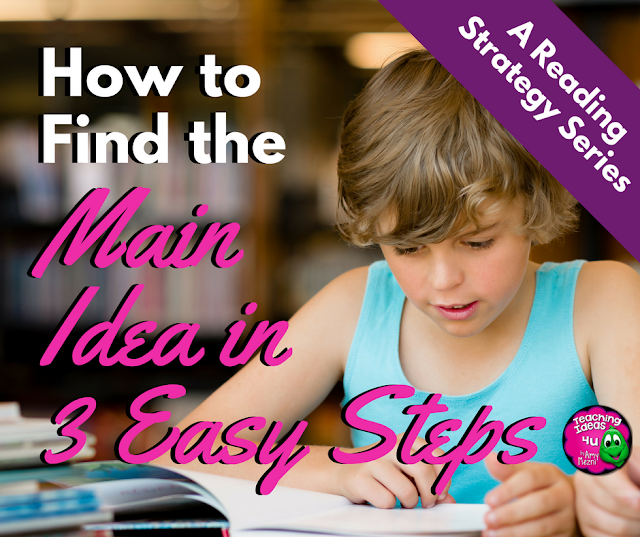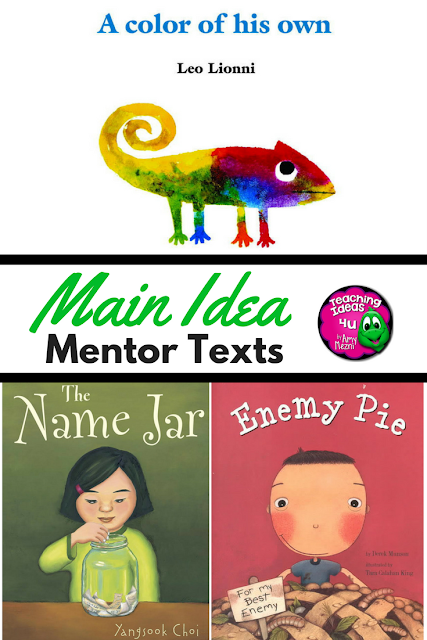How to Find the Main Idea in 3 Easy Steps
There are a few basic reading strategies that will help students improve their reading comprehension. Teaching students how to identify the main idea of a text is an effective way to increase their understanding of the reading. The main idea is exactly what it says, the main or most important idea that the reader should take away from reading the passage. In other words, it is the point that the author wants the reader to understand.
Teaching Main Idea
Before teaching students how to identify the main idea, teachers should make sure that students already understand a few other reading concepts. This will help prevent students from confusing the reading concepts.
- Topic - whom or what the passage is about
- Topic Sentence - the sentence in the paragraph that states the main idea
- Author's Purpose - what the author wants the reader to understand
- Theme - a subject or topic that is repeated throughout a text or multiple texts
Once students understand these topics, they are ready to begin main idea.
Visual Clues
For some books and passages, teaching students to look at visual clues is a great way to determine the main idea. For example, if a text has photographs or illustrations, the reader should think about what is being shown. A book that is about the life cycle of a frog should have images of an egg, tadpole, frog, etc. Another visual clue is the title. The title usually tells the reader what the passage will be about. Back to the life cycle of a frog - if it is about a frog, the title will probably mention frogs.
The GIST Strategy
A commonly used strategy for teaching main idea is GIST. GIST helps students to understand that the main idea of a passage is not a summary - something many students mix up. A summary is longer than the main idea. With GIST, students narrow down the main idea to one sentence, ranging from 10 - 20 words depending upon the grade level. That one sentence should state the ONE key idea that the reader should understand from the passage. GIST can be broken down into three steps:
- Step 1 - Determine who or what is the focus of the text.
- Step 2 - What is the most important thing about the who or the what from step one?
- Step 3 - Write a sentence using the answers from steps one ad two. That sentence is the main idea!
Mentor Texts for Main Idea
Every book or reading passage has a main idea, but it is easier to identify in some texts. Nonfiction articles, such as a magazine or newspaper article, will have strong main ideas. In addition, there are a number of picture books that are excellent mentor texts for teaching main idea, including:
- Enemy Pie by Derek Munson
- The Name Jar by Yansook Choi
- A Color of His Own by Leo Lionni
Evaluating Students
When it comes to teaching reading strategies, there can be pressure for grading students on the strategy. In my opinion, I feel that grading students to heavily on whether or not they can apply a strategy can really backfire. Why are you teaching the strategies? You want students to improve their reading comprehension. A struggling reader is just going to shut down if they know they are going to be graded on every step.
Instead of grading students on their application of the strategy, use your evaluation to help you create reading groups. Students that clearly understand the strategy could be groups together and taught the next strategy. Students that seem to be catching on could be placed together to practice for more practice. Your readers that just are not getting it could be in a group to work with you on the strategy. Remember, the end goal is to increase their reading comprehension, and that is what is most likely being graded. The reading strategy is a means to reach the end goal.
My school has been teaching these reading strategies, and the teachers wanted resources to hep students remember the strategies. They also wanted to have a way to evaluate students' understanding of the strategies. In order to meet the teacher needs, I created a resource for each strategy. The resources come in printable and interactive notebook formats, and the strategy is taught over five days. If you are interested, you can find the main idea unit in my store.



